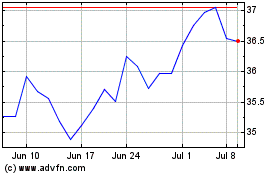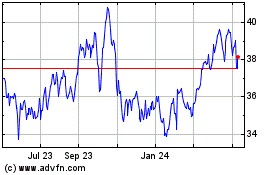Gazprom Cuts Staff by 20% in London Trading Business, Sources Say
November 18 2016 - 11:40AM
Dow Jones News
Gazprom has made deep cuts to its London-headquartered trading
business, in an early sign of the Russian gas giant's attempts to
adjust to continued weakness in commodity markets.
Gazprom Marketing & Trading, a subsidiary of Gazprom Group,
has cut staff numbers by around 20%, including at least six
directors, two people familiar with the matter said.
The unit anticipates a massive fall in some of its divisions'
profits this year, which come from trading oil, gas and other
commodities, these people said.
Like other energy majors, Gazprom has been hit by weak oil and
gas prices, but the company is also battling increased competition
in its east European backyard.
The London cost cuts offer a rare glimpse into changes at an
opaque company that analysts say has been slow to adapt to current
conditions.
Up to 170 people in London will go—a fraction of the majority
state-owned group's 462,400 employees. But analysts expect the
company will need more adjustment.
The cuts to trading may also be a blow to Gazprom's attempts to
diversify away from its traditional pipeline gas exports.
"Gazprom is now adapting to the new world and the new world is
lower costs everywhere," said Thierry Bros, senior research fellow
at the Oxford Institute for Energy Studies.
The staff reductions follow a review by consultancy Oliver
Wyman, which was asked to look for cost savings, the people
familiar with the matter said. Both Oliver Wyman and Gazprom
declined to comment.
"Selling gas in Europe may not be as profitable as people were
thinking, with prices lower, you have to reduce costs everywhere so
you have to move into a low-cost business model," Mr. Bros
said.
A fall in the ruble has cushioned declines in dollar-denominated
oil and gas for Gazprom. But the price of energy has plummeted
since 2014. Gazprom's profits fell 17% to 245 billion rubles in the
second quarter this year and 5% in the first quarter of the
year.
Some of the world's largest energy companies have initiated big
cuts in recent years.
Royal Dutch Shell PLC, the world's second largest gas producer
after Gazprom, has cut at least 12,500 staff since 2015—it now has
94,000 employees, according to its website.
In January, BP PLC said it would slash about one-sixth of its
24,000 exploration and production staff and other major oil
companies have cut in their workforce.
While Gazprom is exporting gas at record levels, and that
resource remains plentiful, the company is facing increased
competition in Eastern Europe.
In recent years, big customers like Poland and Lithuania have
set up gas import terminals to reduce their dependence on gas piped
in from Russia. That boosts their negotiating power with the
company, which was forced to cut prices and reduces Moscow's
leverage at a time of geopolitical tension.
Write to Sarah McFarlane at sarah.mcfarlane@wsj.com and Laura
Mills at Laura.Mills@wsj.com
(END) Dow Jones Newswires
November 18, 2016 11:25 ET (16:25 GMT)
Copyright (c) 2016 Dow Jones & Company, Inc.
BP (NYSE:BP)
Historical Stock Chart
From Mar 2024 to Apr 2024

BP (NYSE:BP)
Historical Stock Chart
From Apr 2023 to Apr 2024
